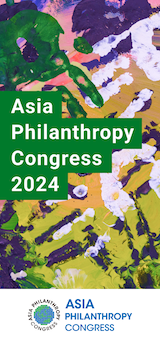In 2016, the Inter-Agency Standing Committee (IASC) launched the Grand Bargain. Heralded as ‘a unique agreement between some of the largest donors and humanitarian organisations,’ 30 national governments and aid agencies committed to 51 pledges to improve humanitarian aid.
Within the first year, a further 18 organisations had signed up. Between them, the 48 signatories controlled 95 percent of global humanitarian spending, which in 2016 stood at $22.72 billion. The 51 pledges signed by the global organisations included strong commitments to prioritise local funding and ensure money went where it was needed most, fast.
‘The Grand Bargain’s purpose is to get more means into the hands of people in need. By increasing efficiency, we can shift resources away from draining backroom activities to frontline delivery,’ the signatories pledged.
The value of the commitment was clear: an increase of 24.6 percent in the amount of funding that went directly to local organisations, from 0.4 percent in 2016 to 25 percent by 2020.
Today, what’s now known as the Grand Bargain 3.0 has 67 signatories. But not only was the goal of 25 percent not reached – the total declined.
Writing in The New Humanitarian in June 2023, policy editor Jessica Alexander noted: ‘The goal set in 2016 to give 25 percent of funding as directly as possible to local organisations, originally by 2020, continues to be an uncomfortable disappointment for the Grand Bargain’s signatories. Direct funding to local actors has actually declined since 2017, both in volume and percentage share of total international humanitarian assistance.’
And it got worse. The UN’s Office for the Coordination of Humanitarian Affairs (OCHA) Financial Tracking Service (FTS) monitors the amount of available global financial humanitarian aid and how it is distributed. At the time of writing, the latest figures available for 2024 (January to April) revealed total donations of US$11.82 billion.
‘Local organisations and their communities are best placed to undertake their own local needs assessments and should be in control of the essential resources they rely on to survive.’
Of this, 92.8 percent was received by international actors including INGOs, private organisations and UN agencies – just under US$10.98 billion. Local NGOs and CSOs received USD$17 million – 0.14 percent of the total aid.
The IASC itself admits the bureaucratic and administrative impediments to humanitarian aid are a cause for concern. It acknowledges common consequences include aid being delayed or obstructed, increased staff and operational costs, and mistrust and misunderstanding between aid workers and affected communities.
In the meantime, vulnerable and marginalised communities are experiencing an increase in climate change emergencies and political instabilities.
‘Between 2010 and 2020, human mortality from floods, droughts, and storms was 15 times higher in highly vulnerable regions, compared to regions with very low vulnerability’ the Intergovernmental Panel on Climate Change noted in its Climate Change 2023 policy report.
‘Human-caused climate change is already affecting many weather and climate extremes in every region across the globe. This has led to widespread adverse impacts and related losses and damages to nature and people. Vulnerable communities who have historically contributed the least to current climate change are disproportionately affected.’
The report goes on to describe these impacts as exposing ‘millions of people to acute food insecurity and reduced water security,’ and notes that the largest adverse impacts are observed in small-scale food producers and low-income households.
But these localised disasters often don’t meet the criteria of a disaster that will set national, let alone international, wheels into motion.
There are no fixed criteria that warrant an international emergency response – it depends on an analysis of needs and resources. INGOs also each have their own criteria: the International Red Cross and Red Crescent Movement, for example, has a three-phase needs assessment that rates response times between 48 hours and 40 days.
While they wait to discover whether they are deserving of aid in the face of their emergency, local communities already battling poverty and poor infrastructure are forced to divert funds from essential services to provide immediate humanitarian relief. Rather than strengthening disaster resilience, their capability is weakened.
It doesn’t have to be like this. We believe that local organisations and their communities are best placed to undertake their own local needs assessments and should be in control of the essential resources they rely on to survive.
As Peace Direct, an international NGO which supports local people in some of the world’s most challenging conflict environments, wrote in a May 2024 open letter to SIDA:
‘CSOs want to establish direct relationships with funders, rather than simply being the recipients of support channelled through INGO intermediaries. Direct funding is not just a matter of equity, trust, efficiency or dignity. CSOs…have the skills and knowledge to best decide how to lift their communities out of poverty, tackle human rights abuses and achieve the sustainable development goals.’
Our new Family for Every Child Frontline Fund does just that. Money from donors goes directly to the communities that need it, within hours. We don’t have international hierarchies of command and approval, or spend time and money training and transporting international rescue teams.
We already have networks of local changemakers on the ground, ready to spring into action. Every organisation in our global alliance is thoroughly vetted and monitored with an ongoing programme of strict quality assurance. When disaster hits, the strong local organisations in our network, which spans 47 organisations in 38 countries, work within their communities to conduct a rapid needs assessment. As soon as we’re notified of those needs we deliver the funds to meet them.
Though the Fund is new, early recipients include Hope Village Society, who are supporting Palestinian refugees in Egypt and ONG Paicabi, helping families affected by wildfire in Chile.
As well as delivering cash on the ground, members learn from each other and provide practical support gained through lived experience. When the war in Ukraine began, our Columbian members were able to immediately deliver support and advice on dealing with conflict situations to the local organisations in affected regions. And the more local organisations that can be supported directly, the more effective the local frontline response will be.
We know the system works. We know it can be replicated. We don’t know why we have to wait for another framework or committee before we can get immediate relief to those who need it.
Amanda Griffiths is the Chief Executive Officer of Family For Every Child





Comments (0)